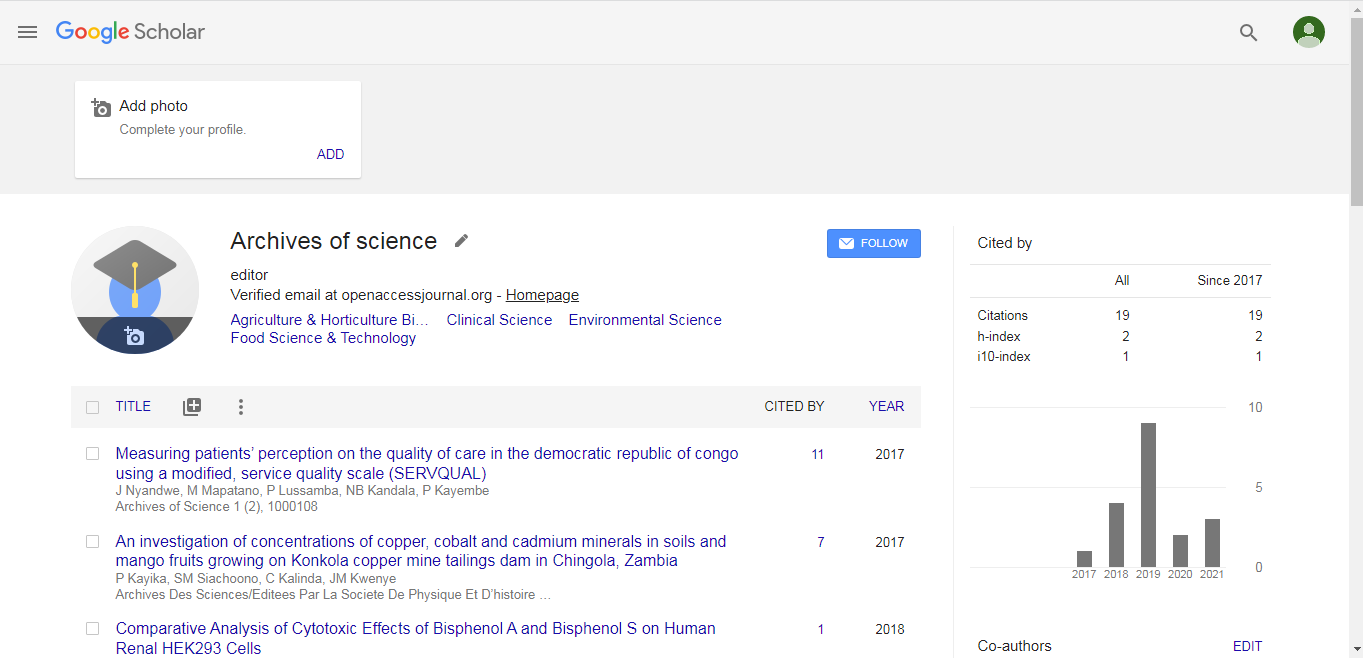Non -thermal electromagnetic fields to trigger on-demand drug release from high-Tm magnetoliposomes - Stefania Petralito- Sapienza University of Rome
*Corresponding Author:
Copyright: © 2021 . This is an open-access article distributed under the terms of the Creative Commons Attribution License, which permits unrestricted use, distribution, and reproduction in any medium, provided the original author and source are credited.
Abstract
Now a days the researches and development within the field of technology has provided a supply of novelty in numerous ground. The yields of nanoscience and nano particles aren't any exception. Nanoparticles ar merely particles within the nanosize vary (10−9 m), sometimes <100 nm in size. thanks to their terribly little size and expanse characteristics, they exhibit distinctive electronic, optical, and magnetic properties that may be exploited for drug delivery. additionally referred to as nanovectors in drug delivery field, they're difficult new tools for controlled unharness of medication as a result of they'll satisfy the 2 most significant criteria for triple-crown medical care, ie, spacial placement and temporal delivery. There are distinctive techniques are established on the premise of the interaction between Magnetic Nanoparticles and liposomes for significant metal detection, interaction between these nano sized materials with cells or alternative biomolecules have huge medicine application as well as cell imaging, bacterium identification, detection of cancer and drug delivery. a brand new system for the precise delivery of the pharmaceutical medication has been established by a team of chemical engineers exploitation trendy nanoparticles inserted during a cyst which might be activated by non-invasive magnetic force fields.
Energy transfer method will occur by the deactivation of donor and also the formation of acceptor in associate degree electronic excited state by 2 separate mechanism. One is FRET, that is especially occur through-space mechanism: which needs the overlap between the emission spectra of donor associate degreed absorption of the acceptor and obtained from the semipermanent dipole-dipole interaction between a donor molecule within the excited state and an acceptor molecule within the state. alternative one is DET, that happens through-bond mechanism.
Magnetic nanoparticles with superparamagnetic properties have attracted exaggerated attention for applications in biomedicine, as they exhibit a robust magnetization only if associate degree external magnetic flux is applied. Magnetoliposomes (MLs) are the mix of liposomes with encapsulated magnetic nanoparticles. These hybrid nanocarriers are showing vital medicine application prospects. However, it's essential that nanoparticles exhibit superparamagnetism, this causes nanoparticles to become at risk of sturdy magnetization. once the magnetic flux is applied, they orient toward this field, however don't retain permanent magnetization within the absence of magnetic flux.
Methodology:
SPIONs are tiny artificial artificial (maghemite), Fe3O4 (magnetite) or α-Fe2O3 (hermatite) particles with a core starting from ten nm to a hundred nm in diameter. additionally, mixed oxides of iron with transition metal ions like copper, cobalt, nickel, and Mn, ar glorious to exhibit superparamagnetic properties and additionally make up the class of SPIONs. However, magnetic iron-ore and magnetic nanoparticles are the foremost wide used SPIONs in numerous medicine applications.
The morphology of Fe2O3 nanoparticles has been glorious to be littered with many factors, as well as the reaction conditions and chemicals concerned. within the presence of surfactants with large organic compound chain structures, like oleylamine and adamantane paraffin, the steric hindrance exerted by surfactants has been shown to have an effect on the form of growing crystals of iron compound throughout synthesis.11 the form of magnetic nanoparticles has not been extensively studied as so much as its impact on biodistribution of SPIONs is concern.
SPIONs have associate degree organic or inorganic coating, on or among that a drug is loaded, and that they ar then guided by associate degree external magnet to their target tissue. These particles exhibit the development of “superparamagnetism”, ie, on application of associate degree external magnetic flux, they become magnetic up to their saturation magnetization, and on removal of the magnetic flux, they now not exhibit any residual magnetic interaction. This property is size-dependent and usually arises once the dimensions of nanoparticles is as low as 10–20 nm. At such alittle size, these nanoparticles don't exhibit multiple domains as found in massive magnets; on the opposite hand, they become one magnetic domain and act as a “single super spin” that exhibits high magnetic susceptibleness. Thus, on application of a magnetic flux, these nanoparticles offer a stronger and a lot of speedy magnetic response compared with bulk magnets with negligible remanence (residual magnetization) and coercivity.
This superparamagnetism, distinctive to nanoparticles, is extremely necessary for his or her use as drug delivery vehicles as a result of these nanoparticles will virtually drag drug molecules to their target web site within the body beneath the influence of associate degree applied magnet field. Moreover, once the applied magnetic flux is removed, the magnetic particles retain no residual magnetism at temperature and thence ar unlikely to agglomerate (ie, they're simply dispersed), so evading uptake by phagocytes and increasing their half-life within the circulation. Moreover, thanks to a negligible tendency to agglomerate, SPIONs cause no danger of occlusion or blockage of blood capillaries.
Results:
The magnetic properties of super magnet iron compound nanoparticles (SPIONs)-based magnetoliposomes yield different therapies through magnetically controlled drug delivery and hyperthermy. during this approach they'll be viewed as trigger-responsive carriers as they need the potential to act as "remote switch" that may activate or off the consequences of the medicine, supported the presence or absence of the stimulant. Recently, a pilot study has incontestable the practicableness of good controlled delivery through a magnetic flux with intensity considerably not up to those sometimes reportable in literature. during this approach, a controlled unharness has been obtained through a magneto-nanomechanical approach with none large temperature increase. Specifically, signals generated by non-thermal alternating magnetic fields (AMFs) or non-thermal periodic magnetic force fields (PEMFs) were applied to high-transition temperature magnetoliposomes (high-Tm MLs) entrapping deliquescent SPIONs, proving to be fascinating and promising stimuli-controlled drug delivery systems.

 Spanish
Spanish  Chinese
Chinese  Russian
Russian  German
German  French
French  Japanese
Japanese  Portuguese
Portuguese  Hindi
Hindi 